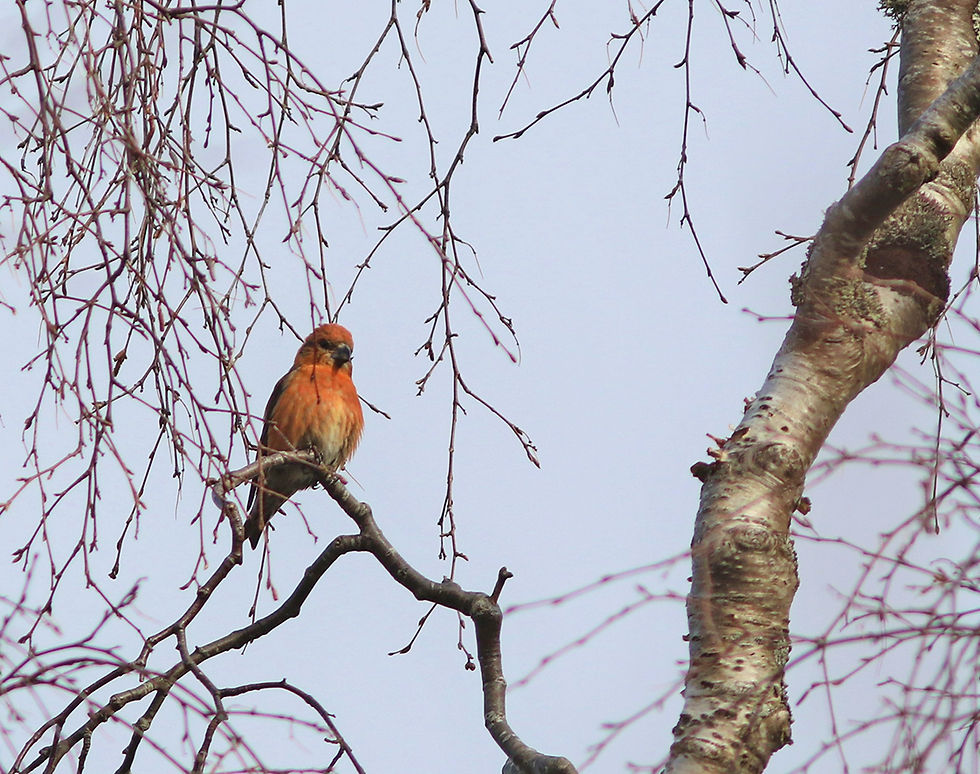Crossbills
- Harris Brooker
- Dec 18, 2023
- 4 min read
Updated: Apr 4

There are currently three species of crossbill recognised in Speyside: the Common Crossbill, the Scottish Crossbill and the Parrot Crossbill, with around six species recognised in the world. Members of the finch family, they have bills which their mandibles crossover. This is an adaptation for extracting the seeds from pinecones. Their genus name is Loxia, the Ancient Greek, meaning ‘Crosswise’.
The crossbills use their bills to prize apart the cones segments and they have barbed tongues which they use to get at the seeds, which in the Scots Pine at least are pale brown and wafer thin. When crossbills are young their bills are initially straight, but curl as they get older.
The taxonomy of crossbills is complicated and are thought to be in a process of species radiation. Whilst some of them can feed on a variety of conifers, all types have their best breeding successes by feeding on particular kinds of conifer. These feeding preferences are said to prevent interbreeding between types and this is said to have helped diversify crossbills genetically, phenotypically (their outward physical appearances) and even speciating - that is, becoming a new species in its own right. The types otherwise look identical but have their own calls which usually need technical analysis to appreciate.

Common Crossbill (Loxia Curvirostra) - The smallest of the three crossbill species, also known in North America as the Red Crossbill, these are often migratory and will feed in Scots Pine but also in Sitka Spruce trees which the other two crossbill species tend to avoid. They have thinner bills with bill tips that can look more hooked. Adults are reddish-orange, females are greenish-yellow and juveniles look greyer with grey barring on the breast. They are typically about twenty centimetres long, weigh between 40-53 grams and have a wingspan of about 27-29 centimetres. The edges of the wings are black but there are very rare individuals that have a single row of white edges to their wings which invites confusion with the Two Barred Crossbill (Loxia Leucoptera), which is a Scandinavian and Asian species that is only very rarely seen in the UK. A true Two Barred Crossbill will have a double, not single row of white wing bars.
If you see crossbills in plantations of non-native trees like Sitka Spruce then the chances are in your favour that they are most likely to be Common Crossbills. They are an irruptive species, that is they can be prone to huge movements when their more local supply of cones in Scandinavia fail. It is from irruptions in the twentieth century that mean that the Common Crossbill is now more or less a resident species. Irruptions of Common Crossbill are said to have been rare, with the first irruption noticed in 1254 by the chronicler Matthew Paris, who described the Crossbill’s as being fond of the pips found in apples. Another irruption was recorded in 1593, with the 1254 one largely forgotten, as they were described as unknown birds in England.
Thomas Bewick, an engraver and naturalist in the 19th Century also described an irruption occurring in 1821. Subsequent later ones established the population that exists today.

Scottish Crossbill (Loxia Scotica) - This is the most controversial one of the three, it is described as being intermediate in size and bill width between the Common and Parrot Crossbill, but this can be difficult to judge. It is considered to be the only endemic vertebrate species to the UK, that is it’s found nowhere else, even then only in Scotland. It is resident and doesn’t migrate. Was once considered a type of Common Crossbill known as Eurasian type 3C.
Like the Common Crossbill, males are orangey-red, females are greenish-yellow. Juveniles have greyish barring. It’s about 16-17 centimetres long, weighs about 44 grams and has a wingspan of about twenty seven to thirty seven centimetres. There are an estimated six thousand eight hundred pairs. They tend to only feed in Scot’s Pine trees, but sometimes also Larches. It is said to have deeper, steelier chipping calls than the Common Crossbill and has been likened to having a ‘Scottish accent’.
It was first regarded by some as a full species as early as 1980, but others felt there was insufficient evidence to say so. After a long-term study by the RSPB it was determined to be a separate species in 2006. Nonetheless, this species status is uncertain because it could one day be downgraded to that of a subspecies, of which it had once been considered.

Parrot Crossbill (Loxia pytyopsittacus) - This is the largest of the three crossbill species and the rarest, with an estimated number of only fifty breeding pairs, with more in Scandinavia and Finland. It was once considered a type of Common Crossbill known as Eurasian type 2D. Males are orangey-red, females are yellowish-green. Juveniles have greyish barring. It has a larger bill and more bull-necked appearance than the other crossbill species, but otherwise looks very similar to the other two.
It likes mainly Scots Pine forest where it eats the seeds of the pine cones and can also eat insects. Its large bill gives it its name and utters the deepest flight calls of the three on average, a deeper ‘choop’ or ‘tyuup’ calls repeated in quick succession. The latter part of its Latin name means ‘pine parrot’.

We can look for crossbills year-round on our Guide Days Out in the Cairngorms – please get in touch if you would like one of our guides to help you find them!
Comments